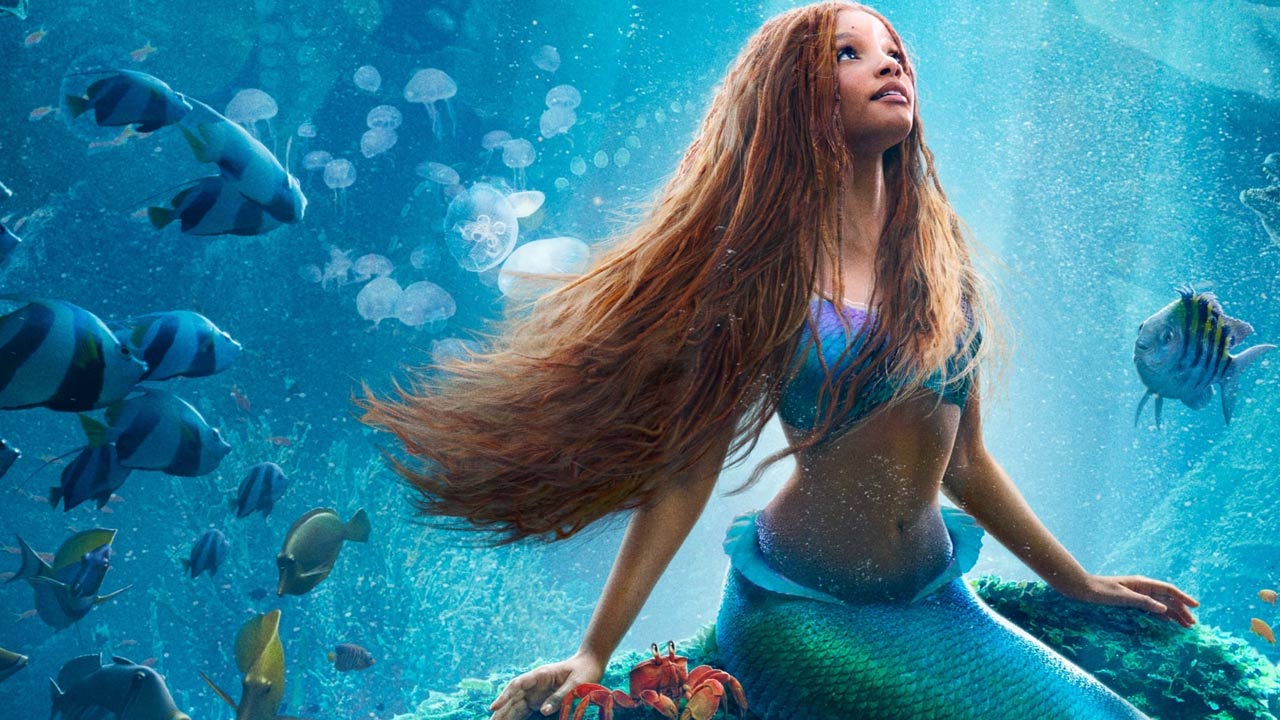Too real, too fake: the freaky fish and crazy dreamworld of The Little Mermaid

From the ocean to the stinky human world, and from animation to slightly-off CGI: Luke Buckmaster dives into The Little Mermaid‘s latest screen transformation.
The Little Mermaid (2023)
The seaweed is always greener in somebody else’s lake. This twist on the famous proverb invoking grass and fences was coined by one of the great bards of the sea: a Jamaican-accented anthropomorphized singing crab named Sebastian. It’s not just a reduxed turn of phrase, befitting the aquatic world, but the core theme of The Little Mermaid. The film, or should I say—with the arrival of Disney’s live action remake of its 1989 animation—films revolve around a mermaid named Ariel who is sick and tired of living in a picturesque, idyllic, fantastical aquatic universe of magic, mirth and dancing crustaceans. So (going out on a limb here) she makes a poor choice and decides to transform into a human, ditching her gill-bearing comrades to embrace a world of oxygen and air-headed people.
My assessment of her decision as poor is based on two core tenets. Firstly, the wisdom of the aforementioned bard—voiced in the new film by Daveed Diggs—who not only constructs a compelling argument (that man it’s much better, down where it’s wetter…) but has the showmanship to express it through a brilliantly catchy song accompanied by intircate coordinated dance. The musical fiesta of “Under the Sea” includes the riding of sea turtles, the tickling of blowfish, and phosphorescent stingrays getting jiggy with it. Like in the original, the song is so good it plays again over the closing credits, as if the filmmakers are saying: “after all that, we gotta admit the crab was right.”
Secondly, Ariel’s transformation into a human was clearly the result of a Faustian bargain—in other words a deal with the devil. The demonic broker is a sea witch named Ursula (now played with cartoonish aplomb by Melissa McCarthy) who stiffs the beautiful nymph so badly, Ariel (Halle Bailey) doesn’t have a voice when human. And she can’t even remember that she needs the handsome prince (Jonah Hauer-King) to smooch her, lest she become Ursula’s slave for eternity. Nevertheless a deal is made and the protagonist cements her fate as a smelly old human.
The new Little Mermaid has an unusual synergy between its protagonist and its aesthetic. Ariel really should’ve been (and was) a mermaid but became human, while the film really should’ve been (and was) animated but became live action. I admit the former is debatable (because “follow your dreams” yada yada) but as for the latter…have you seen Sebastian and Ariel’s other little friend, the stripy tropical fish Flounder (Jacob Tremblay)? Their presences were constant immersion breakers, pulling me out of the narrative world. They look weird and freaky and it ain’t right. The film’s impressive photorealism only makes things less believable, presenting in Flounder a fish that looks like it really should act like a fish, only for it to speak and sing and squeal and look at us with its strange beady little eyes and curved, smiling mouth.

From Disney/Instagram
This speaks to an unresolvable tension throughout the film: the desire to transform visually implausible things into photorealistic depictions. The Big Mouse attempted something similar in remakes of The Jungle Book and The Lion King, but here it feels different. Partly because of the underwater settings, partly because of the improved technology, and partly due to the human-centric nature of this narrative, mixing worlds and juxtaposing real people alongside fantastical creatures (whereas The Lion King is entirely inhabited by animals and The Jungle Book mostly by animals).
Characters breaking into song adds to the strangeness, as does a plot development involving the ethereal-voiced protagonist becoming mute. This means the human star of the show, Halle Bailey, must carry crucial scenes without talking. It’s a challenge Bailey spectacularly succeeds at: the 23-year-old star is an amazing, magnetic presence, holding herself so well, and oozing charm and dignity, in a film where something always feels a little off. Pacing wise it lacks punch, but director Rob Marshall lets individual scenes breathe, which can be a good thing. For instance the “kiss the girl” number, in which Sebastian conspires with fellow creatures, great and small, to engineer a romantic atmosphere enticing the prince to kissing Ariel, is a truly sweet slab of gaslighting.
But it’s so…odd. Marshall doesn’t acknowledge the sheer strangeness of what’s going on: there’s no winking to the audience, no self-consciousness. He plays it straight while the all-singing, all-dancing sea creatures beam in from a whacked-out alternate universe. Google “Sebastian toy The Little Mermaid” and you’ll find tonnes of cute plush things of the original character from the original movie. The new-look sea bard doesn’t appear to be anywhere. This may be Disney’s way of tacitly acknowledging that any toy faithful to the reduxed Sebastian is the stuff of nightmares and many decades of counseling.
Come to think of it, maybe Ariel’s decision to become human wasn’t a poor choice after all: this way she can leave the water, get a pair of legs, and run for the hills.



















